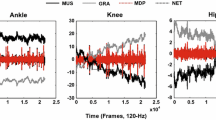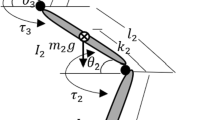Abstract
A recurrent integrator proportional integral derivative (PID) model that has been used to account for cerebrocerebellar stabilization and scaling of transcortical proprioceptive feedback in the control of horizontal planar arm movements has been augmented with long-loop force~feedback and gainscheduling to describe the control of human upright balance. The cerebellar component of the controller is represented by two sets of gains that each provide linear scaling of same-joint and interjoint long-loop stretch responses between ankle, knee, and hip. The cerebral component of the model includes a single set of same-joint linear force feedback gains. Responses to platform translations of a three-segment body model operating under this hybrid proprioception and force-based long-loop control were simulated. With low-velocity platform disturbances, ‘‘ankle-strategy’’-type postural recovery kinematics and electromyogram (EMG) patterns were generated using the first set of cerebeller control gains. With faster disturbances, balance was maintained by including the second set of gains cerebellar control gains that yielded ‘‘mixed ankle-hip strategy’’-type kinematics and EMG patterns. The addition of small amounts of simulated muscular coactivation improved the fit to certain human datasets. It is proposed that the cerebellum switches control gainsets as a function of sensed body kinematic state. Reduction of cerebellar gains with a compensatory increase in muscular stiffness yielded posture recovery with abnormal motions consistent with those found in cerebellar disease. The model demonstrates that stabilized hybrid long-loop feedback with scheduling of linear gains may afford realistic balance control in the absence of explicit internal dynamics models and suggests that the cerebellum and cerebral cortex may contribute to balance control by such a mechanism.
Similar content being viewed by others
References
Allen GI, Tsukahara N (1974) Cerebrocerebellar communication systems. Physiol Rev 54:957–1006
Allum JH, Honegger F (1992) A postural model of balance-correcting movement strategies. J Vestib Res 2(4):323–347
Ayaso O et al (2002) Coarse gain recurrent integrator model for sensorimotor cortical command generation. In: Proceedings of the American control conference, Anchorage, AK
Bloedel JR, Courville J (1981) Cerebellar afferent systems. In: Bookhart JM, Mountcastle VB, Brooks VB, Geiger SR (eds) Handbook of physiology: The nervous system II, Sect I, vol II; Motor control, part 2. American Physiological Society, Bethesda, MD, pp 735–829
Braitenberg V (1967) Is the cerebellar cortex a biological clock in the millisecond range? Prog Brain Res 25:334–346
Brand RA et al (1986) The sensitivity of muscle force predictions to changes in physiological cross-sectional area. J Biomech 8:589–596
Brindley GS (1969) The use made by the cerebellum of the information that it receives from sense organs. Int Brain Res Org Bull 3:80
Brodal A (1981) Neurological anatomy in relation to clinical medicine. Oxford University Press, New York
Delp SL et al (1999) Variation of rotation moment arms with hip flexion. J Biomech 32:493–501
Diener HC, Dichgans J (1992) Pathophysiology of cerebellar ataxia. Mov Disord 7(2):95–109
Eccles JC et al (1967) The cerebellum as a neuronal machine. Springer, Berlin Heidelberg New York
Eccles JC et al (1974a) Temporal patterns of responses of interpositus neurons to peripheral afferent stimulation. J Neurophysiol 37:1427–1437
Eccles JC et al (1974b) Patterns of convergence onto interpositus neurons from peripheral afferents. J Neurophysiol 37:1438–1448
Feldman AG (1986) Once more on the equilibrium-point hypothesis (lambda model) for motor control. J Mot Behav 18(1):17–54
Flash T (1987) The control of hand equilibrium trajectories in multi-joint arm movements. Biol Cybern 57:257–274
Franklin GF et al (1994) Feedback control of dynamic systems, 3rd edn. Addison-Wesley, Reading, MA
Fuglevand AJ, Winter DA (1993) Models of recruitment and rate coding organization in motor-unit pools. J Neurophysiol 70(6):2470–2488
Fujita K, Sato H (1998) Intrinsic viscoelasticity of ankle joint during standing. In: Proceedings of the 20th annual international conference of the IEEE engineering in medicine and biology society, 20(5):2343–2345
Goodwin GC, Sin KS (1984) Adaptive filtering prediction and control. Prentice-Hall, Englewood Cliffs, NJ
Hallett M et al (1975) EMG analysis of stereotyped voluntary movements in man. J Neurol Neurosurg Psychiatry 38:1154–1162
Hasan Z (1983) A model of spindle afferent response to muscle stretch. J Neurophysiol 49(4):989–1006
Hemami H, Katbab A (1982) Constrained inverted pendulum model of evaluating upright stability. J Dyn Meas Syst Control 104:343–349
Henry SM et al (1998) Control of stance during lateral and anterior/posterior surface translations. IEEE Trans Rehabil Eng 6(1):32–42
Horak FB, Nashner LM (1986) Central programming of postural movements: adaptation to altered support-surface configurations. J Neurophysiol 55(6):1369–1381
Horak FB, Diener HC (1994) Cerebellar control of postural scaling and central set in stance. J Neurophysiol 72(2):479–493
Hore J, Flament D (1986) Evidence that a disordered servo-like mechanism contributes to tremor in movements during cerebellar dysfunction. J Neurophysiol 56:123–136
Hore J, Vilis T (1984) A cerebellar-dependent efference copy mechanism for generating appropriate muscle responses to limb perturbations. In: Bloedel JR, Dichgans J, Precht W (eds) Cerebellar functions. Springer, Berlin Heidelberg New York, pp 24–35
Hore J, et al (1976) Responses of cortical neurons (areas 3a and 4) to ramp stretch of hindlimb muscles in the baboon. J Neurophysiol 39:484–500
Ito M (1972) Neural design of the cerebellar motor control system. Brain Res 40:81–84
Ito M (1984) The cerebellum and neural control. Raven, New York
Ito M (1990) A new physiological concept on cerebellum. Rev Neurol Paris 146(10):564–569
Ito M (1997) Cerebellar microcomplexes. In: Schmahmann JD (ed) The cerebellum and cognition, vol 41. Academic, pp 475–487
Jo S (2002) A model of cerebellum-mediated long-loop control of upright balance. In: Proceedings of the 32nd annual meeting of the Society for Neuroscience, Orlando, FL
Johansson R et al (1988) Identification of human postural dynamics. IEEE Trans Biomed Eng 35(10):858–869
Johnson MTV, Ebner TJ (2000) Processing of multiple kinematic signals in the cerebellum and motor cortices. Brain Res Rev 33:155–168
Katayama M, Kawato M (1993) Virtual trajectory and stiffness ellipse during multijoint arm movement predicted by neural inverse models. Biol Cybern 69:353–362
Kettner RE et al (1997) Prediction of complex two-dimensional trajectories by a cerbellar model of smooth pursuit eye movement. J Neurophysiol 77:2115–2130
Kuo A (1995) An optimal control model for analyzing human postural balance. IEEE Trans Biomed Eng 42(1):87–101
Lacquaniti F, Soechting JF (1986) Simulation studies on the control of posture and movement in a multi-jointed limb. Biol Cybern 54:367–378
Leigh JR, Zee DS (1991) The neurology of eye movements. In: Plum F et al (eds) Contemporary neurology series, 2nd edn. FA Davis, Philadelphia, p 402
Li C-SR et al (2001) Neuronal correlates of motor performance and motor learning in primary motor cortex of monkeys adapting to an external force field. Neuron 30:593–607
Mann MD (1973) Clarke’s column and the dorsal spinocerebellar tract: a review. Brain Behav Evol 7:34–83
Martin TA et al (1996) Throwing while looking through prisms: I. Focal olivocerebellar lesions impair adaptation. Brain 119:1183–1198
Massaquoi SG (1999) Modelling the function of the cerebellum in scheduled linear servo control of simple horizontal planar arm movements. PhD thesis Department of Electrical Engineering and Computer Science, MIT, Cambridge, MA, p 240
Massaquoi SG, Hallett M (1997) Ataxia and other cerebellar syndromes. In: Jankovic J, Tolosa E (eds) Parkinson’s disease and movement disorders -3. Williams and Wilkins, Baltimore
Massaquoi SG, Hallett M (1998) Ataxia and other cerebellar syndromes. In: Jankovic J, Tolosa E (eds) Parkinson’s disease and movement disorders. Williams and Wilkins, Baltimore, pp 523–686
Massaquoi SG, Slotine J-JE (1996) The intermediate cerebellum may function as a wave-variable processor. Neurosci Lett 215:60–64
Massaquoi SG, Topka H (2002) Models of cerebellar function. In: Pandolfo M, Manto M (eds) The cerebellum and its disorders. Cambridge University Press, Cambridge, pp 69–94
Miall RC et al (1993) Is the cerebellum a Smith predictor? J Mot Behav 25:1993
Nashner LM, Black FO, Wall C (1982) Adaptation to altered support and visual conditions during stance: patients with vestibular deficits. J Neurosci 2(5):536–544
Nashner LM, McCollum G (1985) The organization of human postural movements: a formal basis and experimental synthesis. Behav Brain Sci 8(1):135–150
Niemeyer G (1996) Using wave variables in time delayed force reflecting teleoperation. Aeronautics and astronautics. PhD thesis, MIT, Cambridge, MA
Ogihara N, Yanazaki N (2001) Generation of human bipedal locomotion by a bio-mimetic neuro-musculo-skeletal model. Biol Cybern 84:1–11
Osborn CE, Poppele RE (1992) Parallel distributed network characteristics of the DSCT. J Neurophysiol 68(4):1100–1112
Oscarsson O (1965) Functional organization of the spino- and cuneocerebellar tracts. Phys Rev 45:495–522
Oscarsson O (1979) Functional units of the cerebellum-sagittal zones and microzones. Trends Neurosci 2:143–145
Park S et al (2004) Postural feedback responses scale with biomechanical constraints in human standing. Exp Brain Res 154:417–427
Paulin MG (1993b) A model for the role of the cerebellum in motor control. Hum Mov Sci 12:5–16
Paulin MG (1997) Neural representations of moving systems. In: Schmahmann JD (ed) The cerebellum and cognition, vol 41. Academic, San Diego, pp 515–533
Peterka R (2001) Sensorimotor integration in human postural control. J Neurophysiol 88:1097–1118
Peterka R (2003) Simplifying the complexities of maintaining balance. IEEE Eng Med Biol Mag 22(2):63–68
Rosenthal NP et al (1970) Frequency analysis of stretch reflex and its main subsystems in triceps surae muscles of the cat. J Neurophyisol 33:713–749
Runge CF et al (1999) Ankle and hip postural strategies defined by joint torques. Gait Posture 10:161–170
Song J et al (1999) A simpified hybrid force/position controller method for the walking robots. Robotica 17:583–589
Spagele T et al (1999) Modelling, simulation and optimisation of a human vertical jump. J Biomech 32(5):521–530
Thach WT et al (1992a) The cerebellum and the adaptive coordination of movement. Annu Rev of Neurosci 15:403–442
Thach WT, et al (1992) Cerebellar output: multiple maps and modes of control in movement coordination. In: Llinas R, Sotelo C (eds) The cerebellum revisited. Springer, Berlin Heidelberg New York, p 283–300
Tremblay L et al (1998) Modifications of reward expectation-related neuronal activity during learning in primate striatum. J Neurophysiol. 80:964–977
Uno Y et al (1989) Formation and control of optimal trajectory in human multijoint arm movement. Biol Cybern 61:89–101
Van der Kooij H et al (1999) A multisensory integration model of human stance control. Biol Cybern 80:299–308
Winter DA (1990) Biomechanics and motor control of human movement, 2nd edn. Wiley, New York
Winters JM (1995) How detailed should muscle models be to understand multi-joint movement coordination? Hum Mov Sci 14:401–442
Wolpert DM et al (1995) An internal model for sensorimotor integration. Science 269:1880–1882
Wolpert DM et al (1998) Internal models in the cerebellum. Trend Cog Sci 2(9):338–347
Author information
Authors and Affiliations
Corresponding author
Rights and permissions
About this article
Cite this article
Jo, S., Massaquoi, S. A model of cerebellum stabilized and scheduled hybrid long-loop control of upright balance. Biol. Cybern. 91, 188–202 (2004). https://doi.org/10.1007/s00422-004-0497-z
Received:
Accepted:
Published:
Issue Date:
DOI: https://doi.org/10.1007/s00422-004-0497-z




